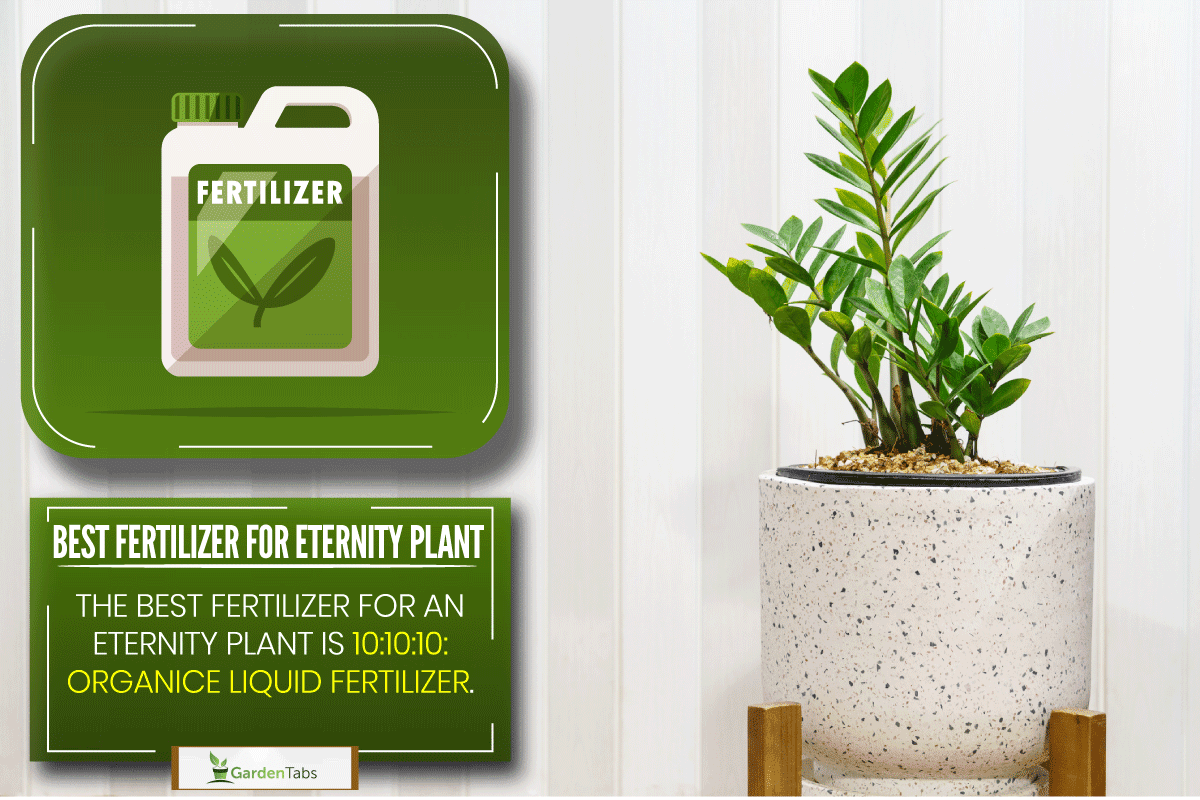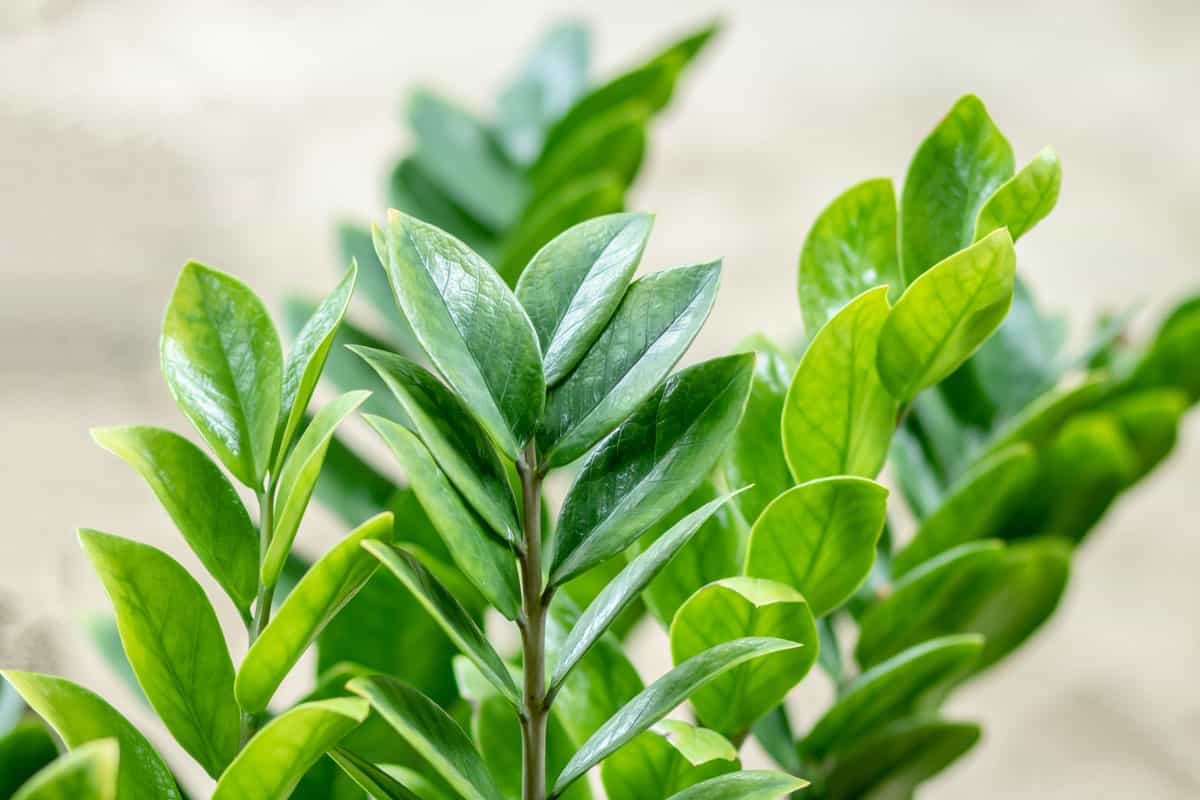The eternity plant is one of the popular houseplants. Not only does it add beauty to a space, but it is also an easy maintenance plant. You may wonder if fertilizer is needed for it to thrive and what kind is best. We will share with you how to use fertilizer and other tips to care for your eternity plant.
The best fertilizer for an eternity plant is a 10:10:10: organic liquid fertilizer. This is a concentrated fertilizer, so it is best to mix this with water.
Caring for an eternity plant is easy, but it has to have the correct maintenance to thrive. In this article, we aim to share information on how to properly care for your eternity plant, including the use of fertilizer.

What Is An Eternity Plant?
Zamioculcas zamiifolia, popularly known as the eternity plant or Zz plant, is a plant that thrives in a tropical climate. It is considered a perennial plant that continues to live for more than two years without replanting.

The distinct look of this plant makes it an attractive indoor decor. The eternity plant has dark green, shiny, and smooth leaves. It can grow up to 18 to 24 inches tall.
This plant also produces flowers between mid-summer to early autumn. Small bright yellow, brown, or bronze spadix grow near the bottom of the stem.
How Do You Care For An Eternity Plant?
The eternity plant is a low-maintenance plant. It is tolerant to different conditions, drought and low light.
It does not need direct sunlight to grow. This kind of plant will thrive best with bright and indirect light.
The optimal temperature for it to thrive is between 64 and 78 degrees Fahrenheit. This makes it an ideal house plant because it can be placed in areas where it is cool in the low-light condition.
One unique part of this plant is its rhizomes. These are roots that look like potatoes. What is great about this kind of root is its capability to store water.
Thus, this plant does not require frequent watering. This will be great in places that experience drought. Water the plant only when the top part of the soil feels dry.

What Type of Fertilizer Should You Use with Eternity Plant?

The eternity plant does not require a lot of maintenance, but it will still thrive with fertilizer. Fertilizer gives additional nutrients to the soil to boost plant growth and healthy plant.
The most common nutrients that fertilizers provide are nitrogen, phosphorus, and potassium. The best fertilizer for an eternity plant should have equal amounts of these micronutrients.
Nitrogen (N) is needed in photosynthesis. Plants that lack this nutrient will not grow or will have slow growth.
Phosphorous (P) is essential in root growth. Soil with insufficient potassium will result in unhealthy roots and plants will not develop. Potassium (K) helps improve the overall health of the plant
Fertilizer packaging will usually have numbers on it. These are the NPK values that the fertilizer contains. When looking for fertilizer, use these values to know which one is best for your plant. Not all fertilizers will have the same value for each nutrient.
Kinds of Fertilizer
There are different fertilizers available to boost the growth of plants. The nutrient content of the different types is mostly the same. Application and length of absorption are what make these fertilizers different. But what is the best fertilizer for the eternity plant?
Liquid fertilizer
The best option for your eternity plant is an organic liquid fertilizer. This will not burn your plant during the summer season. It is also easy to mix and use.
Application is consistent as each drop contains the same formulation. Plants readily absorb this fertilizer as well.
Liquid fertilizer should have a 10:10:10 balanced ratio of the micronutrients. Dilute this with water so it is not too harsh on the plant. Instructions on how to mix can be found on the label.
The mixture can be sprayed on the plant with the leaves absorbing the needed nutrient. However, this is not long-lasting during the growth season. Pouring the mixture into the soil allows the nutrients to be absorbed and stay longer in the soil.
Check out this 10-10-10 liquid plant food on Amazon
Granular Fertilizer
Another kind of fertilizer is in pellet or granular form. The nutrients it contains are different for each kind of granule fertilizer. Unlike liquid fertilizers, the application of granular fertilizer is not uniform so nutrients absorbed may not be the same in all areas.
The biggest advantage of this fertilizer is its slow release characteristics. It releases the nutrients slowly over some time. It may take longer for the plants to absorb the nutrients but they will have fertilizer for a longer period.
Check out this smart-release plant food on Amazon
DIY Fertilizer
Coffee grounds are an option as a natural fertilizer. Coffee grounds have a high content of nitrogen and other nutrients.
Often, this is added on top of the soil. But this covers the soil and doesn't allow water to evaporate. Roots rot when is water retained for long.
Mixing it with the soil is better as it helps the soil to have better water drainage. The solid particles make the soil not too compact and create spaces for the water to pass through.
Use coffee grounds to make natural fertilizer for your plants. Add equal amounts of leaves and cut grass with the coffee grounds to the compost pile.
How Often Should You Fertilize?
Liquid fertilizer should be fed to the soil every four weeks during the growing season. This will be between spring and summer.
On the other hand, slow-release fertilizer is applied every three to four months. Application is not needed often as it will release nutrients over time.
What Are The Benefits Of An Eternity Plant?

Aside from being an easy-to-care-for plant, the eternity plant has other benefits when placed indoors.
Air Purifier
For one, it is a great air purifier. It cleans pollutants that come from smoke, chemicals, and other harmful compounds.
It also absorbs carbon dioxide. What this plant does is filter these toxic materials from the air and release fresh and clean oxygen. This makes it easy for people to breathe and improves cognitive function.
Easy to Propagate
An eternity plant is easy to propagate. One way is to divide the rhizomes and plant them separately in pots. Since eternity plants are good houseplants, choose a planter that is pleasing to the eye. Use a pot that drains water well to prevent root rot.
Check out this white ceramic pot with drainage holes on Amazon
Another option is to cut a stem and place it in a jar with water. Remove a few leaves from the stem before doing this. The plant then can be placed where it will get indirect light.
To avoid bacterial growth, it is best to change the water at least once a week. This method is easy but will take at least six to nine months to grow roots.
Once roots are present, plant this using a good draining potting soil. This avoids water retention in the soil. Also, it has nutrients that the plant needs to continue growing.
Check this indoor potting mix on Amazon
Adaptability
The eternity plant is one of the sturdiest plants. It can adapt to different light conditions, be it low light or under the sun. This makes the plant thrive outdoor or indoors. It can even thrive in offices where only fluorescent light is available.
As a decorative plant, it can be used as a tabletop or a floor plant. It can grow in different containers so you can spruce up your space in different pots and ways.
Why Is My Eternity Plant Dying?

An eternity plant retains water well because of its rhizomes. Overwatering can still occur, though. When there's too much moisture in the soil, the roots become too wet and rot.
This will prevent it from absorbing oxygen and won't be able to send water to the plant. Since plants need both oxygen and water, lacking these can cause your plant to die.
Yellow leaves are one of the common signs of overwatering. The leaves can also have brown tips or wrinkled leaves. Drooping stems may also be a telling sign that there's too much water in the soil.
Often what is needed is to remove the plant from the pot to inspect the roots. Brown or soft roots are signs of rotting roots.
Remove these with clean pruning shears. Then wash the healthy roots and plant these again in new potting soil. Do not use the old soil, as this contains bacteria from the rotten root.
Check out these pruning shears on Amazon
In Conclusion

Liquid fertilizer has nutrients that allow the eternity plant to thrive indoors as well as outdoor. We hope that this article has helped give you tips on how to take care of your eternity plant well.
We have other articles on plant care that may interest you as well.





